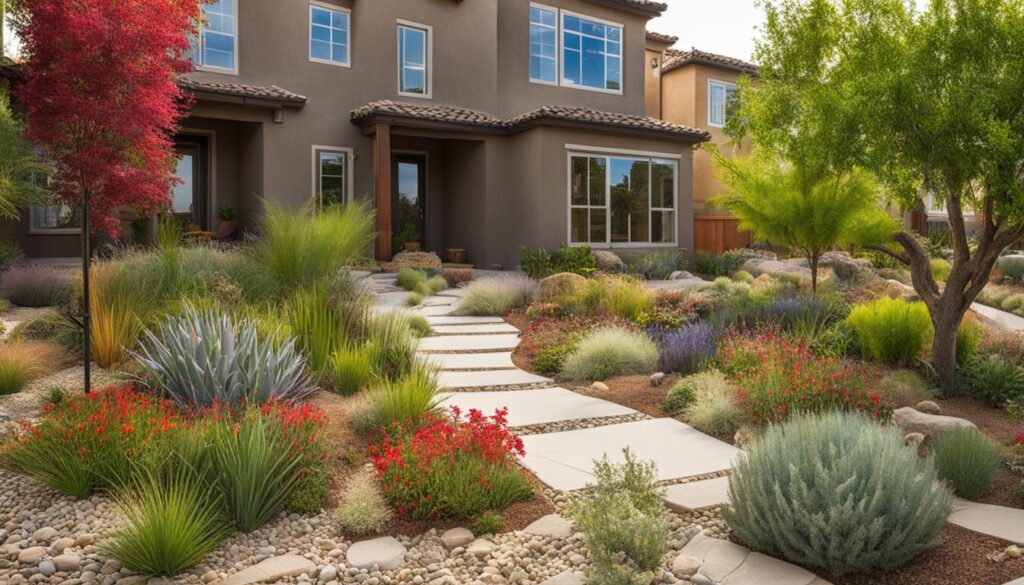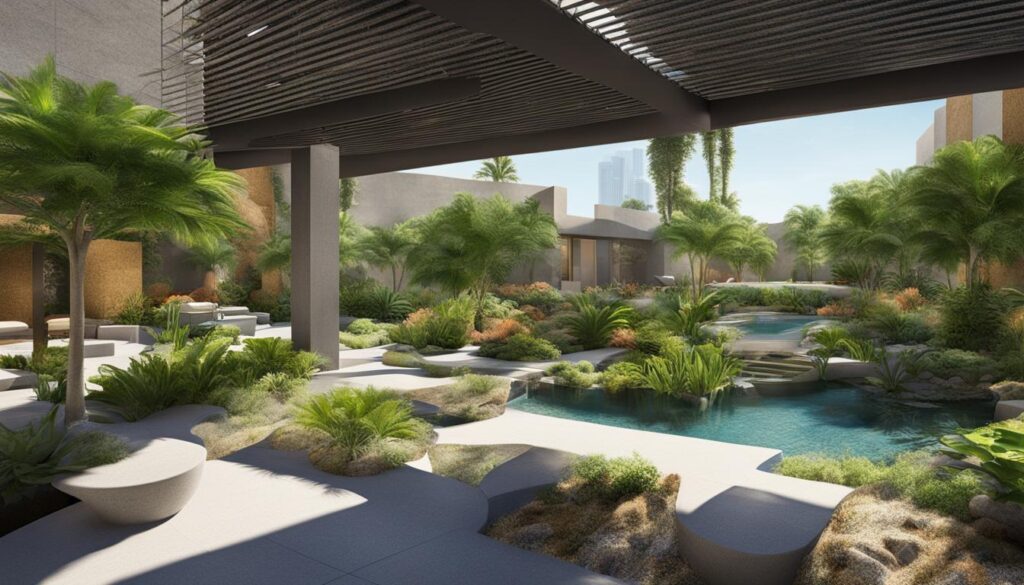Welcome to our guide on xeriscaping, the innovative landscaping technique that offers sustainable and water-efficient solutions for urban environments. With growing concerns about water conservation and the need for sustainable landscapes, xeriscaping has emerged as a practical and eco-friendly approach for homeowners in cities.
Xeriscaping focuses on creating beautiful outdoor spaces that require minimal irrigation and maintenance, making it an ideal choice for those passionate about conservation and sustainability. By implementing xeriscaping techniques, you can contribute to water conservation efforts while still enjoying a vibrant and visually appealing landscape in the heart of the city.
Key Takeaways:
- Urban xeriscaping offers sustainable and water-efficient landscaping solutions for city dwellers.
- By using efficient irrigation systems and water-wise plant selections, xeriscaping can significantly reduce water consumption.
- Xeriscaping promotes the creation of visually appealing landscapes that require minimal maintenance.
- Implementing xeriscaping techniques can help mitigate the heat island effect and create a cooler and more comfortable outdoor environment.
- Xeriscaping plays a critical role in water conservation efforts, contributing to the sustainability of our urban environment.
The Concept of Xeriscape
Xeriscape is a landscaping concept that focuses on water conservation and sustainable landscape design in urban environments. With efficient irrigation systems and careful plant selection, xeriscaping allows you to create a beautiful and water-efficient outdoor space. Unlike traditional landscapes, xeriscaping doesn’t mean sacrificing beauty or lushness. It’s about designing a landscape that is well-adapted to the local climate and requires minimal supplemental water.
When implementing xeriscaping techniques, planning and design are essential. Consider the overall layout and factors such as sun exposure, soil type, and slope. Efficient irrigation systems, such as drip irrigation, ensure water is delivered directly to the plants’ roots, minimizing water waste. By using mulch and properly preparing the soil, you can improve water retention and reduce evaporation.
Plant selection is a crucial aspect of xeriscaping. Choose drought-tolerant and native plants that are well-suited to your region’s climate. These plants have adapted to local conditions, requiring less water and maintenance. Additionally, appropriate maintenance practices, such as regular pruning and weed control, help keep your xeriscape looking its best.
Key points:
- Xeriscape focuses on water conservation and sustainable landscape design.
- Efficient irrigation systems and careful plant selection are key components of xeriscaping.
- Proper planning and design, efficient irrigation, soil preparation, and appropriate plant selection contribute to a successful xeriscape.
- Maintaining your xeriscape through regular pruning and weed control ensures its long-term beauty and functionality.
The Benefits and Challenges of Xeriscaping
Xeriscaping offers numerous benefits for homeowners and the environment. One of the key advantages is water conservation. By using plants that are well adapted to the local climate and require less water, xeriscaping can significantly reduce the amount of water needed for irrigation. This not only helps to conserve water, but also lowers water bills, making it a cost-effective solution in the long run.
Another benefit of xeriscaping is reduced maintenance. With the right plant selection and design, xeriscaped landscapes require less upkeep compared to traditional lawns and gardens. By choosing low-maintenance plants and incorporating mulch to suppress weeds, homeowners can spend less time and effort on watering, mowing, and other tasks associated with traditional landscaping.
However, there are also some challenges to consider when it comes to xeriscaping. One challenge is the potential for higher temperatures in desert landscapes. Without the shade provided by water-intensive trees and turf-grass, xeriscaped areas can experience increased heat due to the lack of evaporative cooling. Careful plant selection and the strategic placement of shade-providing structures can help mitigate this issue.
The Heat Island Effect
The heat island effect is another challenge associated with xeriscaping in urban areas. The removal of water-intensive vegetation can result in higher air and surface temperatures, especially in densely populated cities. However, there are strategies to address this issue, such as incorporating a mix of high- and low-water-use plants and using materials that reflect rather than absorb heat. These measures can help maintain a comfortable outdoor environment while still achieving water conservation goals.
Overall, xeriscaping offers numerous benefits, including water conservation, reduced maintenance, and lower water bills. While there are some challenges to overcome, with proper planning, plant selection, and irrigation management, xeriscaping can be a sustainable and environmentally-friendly approach to landscaping in urban environments.
Implementing Xeriscaping Techniques
Implementing xeriscaping techniques involves several key steps that will help you create a water-efficient and visually appealing landscape. By following these techniques, you can significantly reduce your water usage and maintenance needs. Here are the essential steps to implement xeriscaping:
- Choose native plants: Select plants that are well adapted to your local climate and require minimal watering. Native plants are naturally suited to the conditions in your area, making them more water-efficient and resilient.
- Install drip irrigation: Opt for a drip irrigation system to efficiently deliver water directly to the roots of your plants. Drip irrigation minimizes water loss through evaporation and ensures that water is only applied where it is needed.
- Prepare the soil: Properly preparing the soil is crucial for optimizing water retention and promoting healthy plant growth. Add organic matter, such as compost, to improve the soil’s ability to hold water and provide essential nutrients.
- Maintain your xeriscape: Regular maintenance is necessary to keep your xeriscape looking its best. This includes regular pruning to control the growth of plants, removing weeds to prevent competition for water, and monitoring irrigation to ensure optimal water usage.
Implementing these xeriscaping techniques will not only save water but also reduce your maintenance efforts and create an attractive and sustainable landscape. By selecting native plants, using drip irrigation, preparing the soil, and practicing appropriate maintenance, you can achieve a water-efficient outdoor space that thrives in your local climate.
The Impact of Xeriscaping on Temperature
Xeriscaping, with its focus on water conservation and sustainable landscaping, has gained popularity in urban areas. However, it’s important to consider the impact of xeriscaping on temperature, particularly in relation to microclimate effects and the urban heat island effect.
A study conducted in an arid region revealed some interesting findings regarding the temperature effects of xeriscaping. The study found that xeriscaping with desert landscaping resulted in lower water requirements but higher temperatures compared to traditional landscapes. This increase in temperature can be attributed to the removal of water-intensive trees and turf-grass, often found in mesic landscapes, which provide shade and help cool the surrounding area. Without these cooling elements, urban areas with xeriscaping may experience higher air or surface temperatures.
While the study highlights the potential temperature increase associated with xeriscaping, it’s important to note that there are strategies available to mitigate these effects. One approach is to incorporate a mix of high- and low-water-use plants in xeriscaping designs. By incorporating more water-intensive plants strategically, such as in shaded areas, the overall temperature increase can be reduced while still achieving water conservation goals.
The Role of Water-Intensive Trees
Water-intensive trees, such as large shade trees, can significantly impact temperature regulation in urban areas. These trees provide shade, which helps to reduce the urban heat island effect by lowering nearby air and surface temperatures. However, in xeriscaping, the removal of water-intensive trees may lead to higher temperatures. It’s crucial to find a balance between water conservation and temperature regulation when planning xeriscaped landscapes.
In conclusion, while xeriscaping offers numerous benefits, including water conservation and reduced maintenance, it’s crucial to consider the impact on temperature. By incorporating a mix of high- and low-water-use plants strategically and understanding the role of water-intensive trees, homeowners can achieve a balance between water conservation and temperature regulation in xeriscaped urban environments.
What are the Benefits of Xeriscaping in Urban Environments for Conservation?
Sustainable xeriscape garden plans offer numerous benefits in urban environments for conservation efforts. By using drought-resistant plants and minimal water usage, xeriscaping reduces water consumption, conserves resources, and promotes healthier ecosystems. Additionally, it requires less maintenance, saving time and money for urban communities.
The Role of Xeriscaping in Water Conservation Efforts
Xeriscaping, with its focus on water use reduction and the use of drought-tolerant plants, plays a crucial role in water conservation efforts, particularly in regions facing water shortages. By implementing xeriscaping techniques, homeowners can achieve significant water savings while still creating beautiful and sustainable landscapes. One prime example of the importance of xeriscaping is evident in the case of Lake Mead in Nevada, where water levels have dropped and drought conditions persist.
“Xeriscaping is becoming more necessary in areas like Nevada, where Lake Mead has dropped and drought conditions persist.”
In response to these challenges, legislation has even been passed to ban ornamental grass and encourage the use of water-efficient landscapes. This highlights the growing recognition of the need to conserve water and promote sustainable landscaping practices. Xeriscaping offers a practical solution by replacing water-intensive grass with landscapes that feature drought-tolerant plants.
The Benefits of Xeriscaping:
- Water use reduction: Xeriscaping significantly reduces the amount of water needed for irrigation, helping to conserve this valuable resource.
- Drought-tolerant plants: By selecting plants that are well adapted to the local climate and require less water, homeowners can create landscapes that thrive even in water-restricted conditions.
- Water savings: Xeriscaping can result in substantial water savings compared to traditional landscaping methods, leading to lower water bills and less strain on water supplies.
Overall, xeriscaping offers a practical and effective solution for water conservation in urban environments. By embracing this approach and implementing xeriscaping techniques, homeowners can contribute to a more sustainable future and ensure the availability of water resources for generations to come.
Conclusion
Xeriscaping offers numerous benefits for water conservation and sustainable landscaping in the urban environment. By implementing xeriscaping techniques, you can contribute to water conservation efforts while creating visually appealing outdoor spaces.
One of the key advantages of xeriscaping is its ability to reduce water consumption. By selecting drought-tolerant plants and using efficient irrigation systems, you can significantly minimize the amount of water needed for maintaining your landscape. This not only helps to conserve water resources but also lowers your water bills.
Furthermore, xeriscaping promotes sustainable landscaping practices by using plants that are well adapted to the local climate and require less water. By creating a water-efficient landscape, you can minimize the environmental impact associated with traditional landscaping methods and contribute to a healthier urban environment.
In conclusion, xeriscaping is a practical and effective solution for water conservation and sustainable landscaping in the urban environment. By implementing xeriscaping techniques, you can create a beautiful outdoor space that not only saves water but also enhances the overall quality of urban living.














